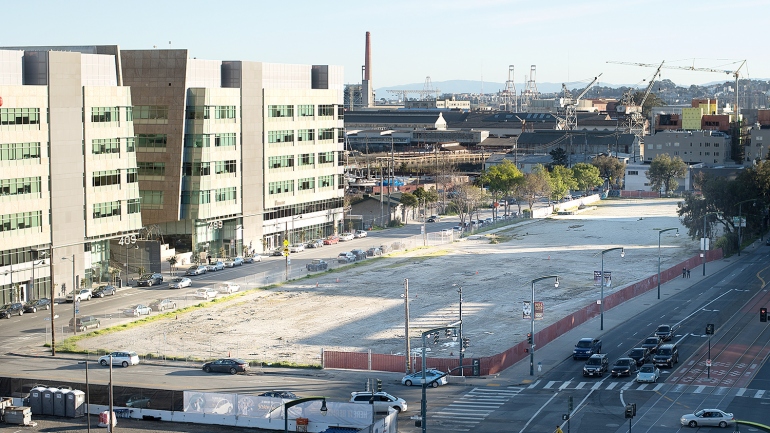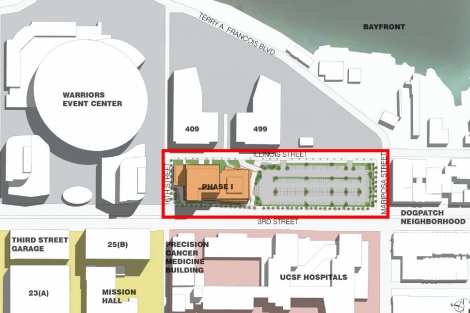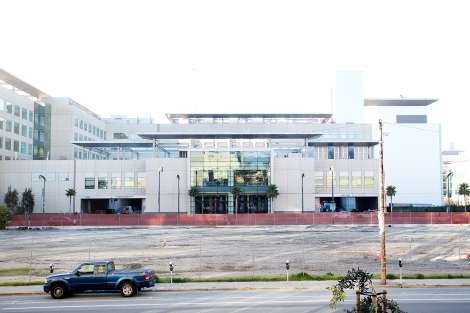UC Regents Approve Budget, Design for Block 33 Building at Mission Bay

UC San Francisco’s new building at Mission Bay to house desktop research, administrative space, and a new Center for Vision Neurosciences with ophthalmology clinics and academic space recently received approval from the UC Regents.
The new 340,000-square-foot building will be constructed on a parcel known as Block 33, which is located at the southeast intersection of Third and 16th streets.
The building consists of three wings: a 12-story tower, a five-story south wing and a three-story north wing with a rooftop garden. While design of the building continues, construction of the project is expected to begin in June 2017 for targeted completion by July 2019.
 The 12-story tower will house academic desktop research and administrative space, and it will use an open-plan design for faculty and staff who will be relocated from multiple UCSF sites such as Parnassus, Mission Center, Mission Bay, Laurel Heights and other leased spaces.
The 12-story tower will house academic desktop research and administrative space, and it will use an open-plan design for faculty and staff who will be relocated from multiple UCSF sites such as Parnassus, Mission Center, Mission Bay, Laurel Heights and other leased spaces.
Programs in the Proctor Foundation and Ophthalmology Department will combine in Building 33 to comprise a new Center for Vision Neurosciences, where clinics and teaching laboratories will be located in a five-story south wing. The north wing of the building will house centralized meeting space, including a three-story conference facility.
The Block 33 building, which will provide a home for scientific initiatives that require desktop space near other UCSF research programs, will be located directly across from UCSF Medical Center at Mission Bay. These include the Institute for Computational Health Sciences, the CERSI/Drug Development Efficacy Research, the Genomic Medicine Initiative Core and the Bio-banking Core.
The UC Regents on Jan. 26:
- Approved the project budget of $237 million and debt or external financing of $159 million and standby financing of $50 million;
- Approved the project scope and design;
- Found the project to be in conformance with the California Environmental Quality; and
- Approved the amendment to the UCSF Long Range Development Plan to designate the functional zoning for the site.
Block 33 comprises the northern portion of a vacant 3.8-acre parcel acquired by UCSF that includes Block 34, as well. It sits directly south of the Golden State Warriors Event Center and arena, which is now under construction.
At build out, Blocks 33 and 34 combined is projected to accommodate 500,000 gross square feet of building area, plus a 500-space parking garage. UCSF does not have immediate plans to develop Block 34.
The design of the Block 33 building is continuing, and it is expected to be finalized and released in February. Construction on the project is expected to begin in June 2017, and it is scheduled to be completed by July 2019.
Incorporating Feedback in Open-Plan Design
The interior of Building 33 will use an open-plan design, which consists of individual work stations and some private offices as well as shared work spaces. The shared workspaces on every floor include such amenities as focus rooms and conference rooms, larger communal areas like shared kitchens, and service centers for copiers and other equipment.
UCSF is using a collaborative design-build project delivery model, an approach that integrates, to the extent possible, feedback from UCSF stakeholders and incorporates proven lean design and construction processes to maximize the space and overall project efficiency.

Like all current and future construction and renovation projects at UCSF, the University is following a decision-making process that includes getting input from future occupants about the interior layouts, functionality, furniture and adjacencies of departments and units located together.
This inclusive process is a result of lessons learned from Mission Hall. After Mission Hall opened amid a flurry of complaints by occupants, a task force appointed by UCSF Chancellor Sam Hawgood, MBBS, developed principles for programming, designing and governing that are now being applied to the construction and renovation of buildings currently in the pipeline.
Among the improvements to be made at Building 33 are: ensuring maximum exposure to light and views with windows within sight of as many occupants as possible; adding private offices to allow for more privacy based on functional need; and addressing issues with technology and way-finding.
As part of the response to deficiencies at Mission Hall, UCSF also engaged the design firm Perkins and Will to work on two fronts: to assess the functional needs of occupants destined to move into future buildings and to study employee satisfaction, engagement and effectiveness in the newly developed workspaces as part of the longitudinal research study.
— Lisa Cisneros contributed to this story.
For more campus news and resources, visit Pulse of UCSF.